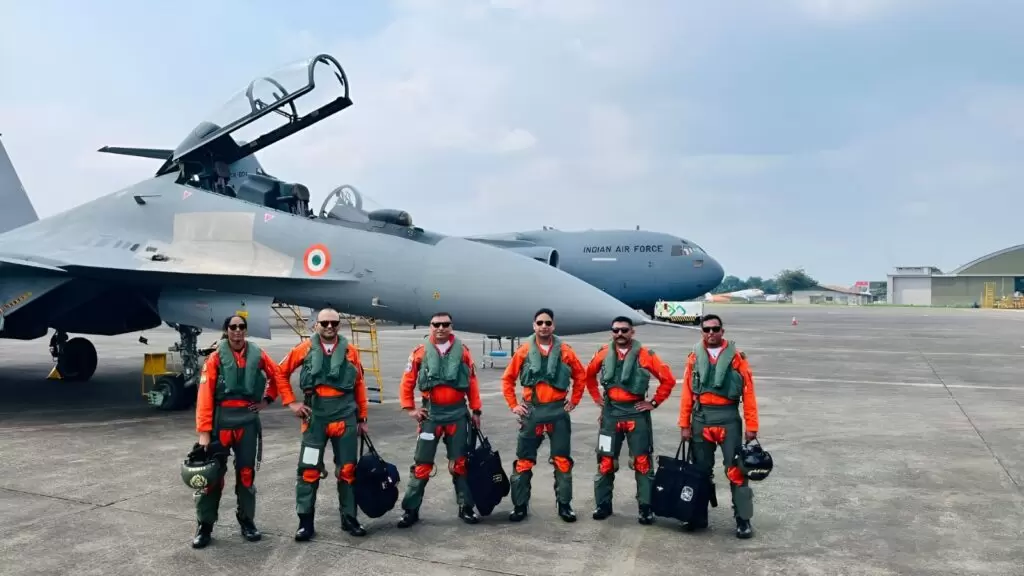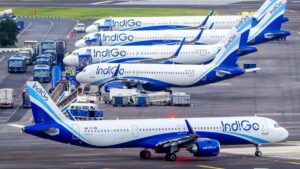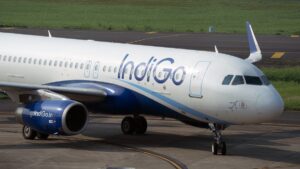Indian Air Force Global Ranking 2025: IAF Ranks Above China’s PLAAF in Global Air Force Rankings – Check Full List

Image Credit: Indian Air Force @IAF_MCC
Table of Contents
- Introduction: India’s Growing Air Dominance
- About WDMMA and Its Global Air Power Ranking
- How the WDMMA TruVal Rating Works
- India’s Position in the 2025 Global Air Power Rankings
- Inside the Indian Air Force: Strength, Structure, and Readiness
- 5.1 Fighter Fleet
- 5.2 Helicopter Fleet
- 5.3 Transport Aircraft
- 5.4 Trainers and Tankers
- 5.5 Special-Mission and Future Procurement
- Comparing India with China and Pakistan
- 6.1 Indian Air Force vs Chinese Air Force
- 6.2 Indian Air Force vs Pakistan Air Force
- Why India’s Ranking Reflects Real Strength
- The Road Ahead for the Indian Air Force
- Conclusion: A Force Ready for the Future
1. Introduction: India’s Growing Air Dominance
The Indian Air Force (IAF) continues to stand tall as one of the most capable air arms in the world. In the World Directory of Modern Military Aircraft (WDMMA) Global Air Powers Ranking 2025, the IAF has secured the 6th position globally, the Indian Air Force (IAF) has secured the 6th position worldwide, ahead of both China and Pakistan. The ranking reflects IAF’s balanced mix of firepower, modernization, and strategic reach.
Indian Air Force Global Ranking 2025 at 6th place showcases not only the size of its fleet but also the quality of its aircraft, the readiness of its squadrons, and the country’s growing aerospace self-reliance.
2. About WDMMA and Its Global Air Power Ranking
The World Directory of Modern Military Aircraft (WDMMA) is a trusted global defence database that tracks and analyses the capabilities of air forces across 103 countries.
Its annual Global Air Powers Ranking assesses over 48,000 aircraft worldwide, evaluating not just numbers but the combat and support capabilities that define true air power.
WDMMA’s ranking is widely respected because it looks beyond fleet size — it factors in modernization, logistics, industry capability, and future procurement.
3. How the WDMMA TruVal Rating Works
At the heart of WDMMA’s assessment is the TruVal Rating (TVR) — a data-driven metric that measures each air service’s total fighting strength.
It considers:
- Quality and quantity of aircraft
- Balance of inventory across fighters, transports, trainers, and support assets
- Modernization and upgrade programs
- Local aerospace manufacturing capacity
- Logistical readiness and maintenance support
- Pilot training standards and mission flexibility
The highest possible TVR in 2025 is 242.9, held by the United States Air Force (USAF).
The Indian Air Force’s TVR of 69.4 puts it firmly at Rank 6 worldwide, making it one of the world’s elite air powers.
4. Indian Air Force Global Ranking 2025
According to the WDMMA 2025 data:

This means the Indian Air Force ranks higher than both China and Pakistan, confirming India’s air power dominance in the region.
For full list of over 100 global rankings of world’s major air forces, please visit https://www.wdmma.org/ranking.php.
Comparison with Chinese and Pakistani Air Forces
In the Indian Air Force Global Ranking 2025, India’s air power clearly surpasses that of its regional adversaries.
China
While China has a larger fleet, it is ranked behind IAF at no. 7. The WDMMA notes that India scores higher in operational readiness, pilot training quality, and real-world mission capability. The IAF’s superior maintenance discipline and combat-tested experience give it an edge in sustained operations.
Pakistan
Pakistan ranks far below India, with a lower TruVal Rating of 46.2. PAF ranks at 18th position globally with its limited high-end platforms. The IAF’s numerical advantage, coupled with superior technology and infrastructure, makes it a dominant regional air power.
5. Inside the Indian Air Force: Strength, Structure, and Readiness
With 1,716 aircraft in service, the IAF remains one of the most diverse and operationally ready air arms globally. Its fleet is divided across fighters, helicopters, transports, trainers, and special-mission platforms.
5.1 Fighter Fleet
- Total Fighters: 542 (approx. 32% of total strength)
- Key Aircraft:
- 259 Su-30MKI multirole fighters
- 79 Jaguar IS strike aircraft
- 40 MiG-29, 31 Mirage 2000H
- 28 Tejas Mk.1 (indigenous)
- 20 Rafale DH/EH multirole jets
- Outlook: Positive — strong modernization push with Tejas Mk.1A and Rafale expansion.
5.2 Helicopter Fleet
- Total: 498
- Key Platforms: Mi-17V-5, Dhruv ALH, Apache AH-64E, Rudra, Chetak, and Chinook CH-47F.
- Roles: Transport, troop support, attack, and special-mission.
- Outlook: Positive — continued expansion through indigenous LUH and Prachand projects.
5.3 Transport Aircraft
- Total: 282
- Key Aircraft: C-17 Globemaster III, C-130J Super Hercules, IL-76, An-32, and Do-228.
- Roles: Strategic and tactical transport, humanitarian relief, and VIP duties.
- Outlook: Positive — CN295W deliveries will enhance tactical lift capacity.
5.4 Trainers and Tankers
- Trainers: 374 aircraft including Hawk 132, Kiran, and PC-7 Mk II.
- Tankers: 6 IL-78 MKI aerial refuelers supporting long-range missions.
- Outlook: Stable — focus on indigenous HTT-40 trainers and advanced simulators.
5.5 Special-Mission and Future Procurement
- Special-Mission Fleet: 14 aircraft including AEW&C systems like Netra and A-50EI, ELINT/SIGINT aircraft such as Global 5000 and G-III SRA.
- On-Order Units: 349 aircraft comprising Tejas Mk.1A, HTT-40, CN295W, Prachand, Rudra, Dhruv, and LUH.
6. Comparing India with China and Pakistan
6.1 Indian Air Force vs Chinese Air Force
The Chinese Air Force (PLAAF), though larger at 3,733 aircraft, is ranked below India (Rank 7) in WDMMA’s 2025 list due to several factors:
- Limited operational experience compared to IAF.
- Dependence on Russian-origin and reverse-engineered platforms.
- Delays in 5th-generation fighter induction.
- Weaker balance between combat and support assets.
- India’s superior pilot training and logistics infrastructure.
India’s consistent modernization and indigenous production have given the IAF an edge in quality, reliability, and mission readiness.
6.2 Indian Air Force vs Pakistan Air Force
The Pakistan Air Force (PAF), with 879 aircraft and a TVR of 46.2, ranks 19th globally.
While capable, the PAF is numerically and technologically outmatched. It relies heavily on JF-17s (co-developed with China) and older F-16s.
Key differences:
- India fields a larger multirole fleet with greater strike range.
- IAF’s superior aerial refueling and AWACS coverage enable sustained operations.
- India’s training and logistics systems are more advanced.
In both technology and capacity, the IAF maintains a decisive advantage.
7. Why India’s Ranking Reflects Real Strength
Indian Air Force Global Ranking 2025 at 6th place comes from more than just numbers. It reflects:
- A balanced and versatile fleet across all categories.
- Continuous modernization programs and indigenous aircraft development.
- Strong training and readiness standards.
- Expanding defence-industrial base (HAL, DRDO, private sector).
- A steady stream of procurements and upgrades ensuring long-term capability.
8. The Road Ahead for the Indian Air Force
The IAF’s roadmap for the next decade is firmly focused on self-reliance and technological advancement.
Priorities include:
- Induction of Tejas Mk.1A and future Tejas Mk.2 aircraft.
- Development of AMCA (Advanced Medium Combat Aircraft) for stealth operations.
- Expansion of AEW&C and aerial tanker fleets.
- Increased focus on unmanned systems and AI-based mission support.
- Strengthened collaboration with Indian industry under Atmanirbhar Bharat.
9. Conclusion: A Force Ready for the Future
The Indian Air Force Global Ranking 2025 in the WDMMA Global Air Powers list confirms India’s rising status as a true aerospace power.
With a modern, balanced, and increasingly indigenous fleet, the IAF is not only defending India’s skies but also projecting its strategic capabilities across the region.
In a world where air dominance defines national strength, the Indian Air Force remains a symbol of India’s confidence, innovation, and readiness for the future.
ALSO READ | Air Chief Flies MiG-21 Before Bidding Farewell to the Iconic Fighter That Served IAF for Six Decades
Sources and Credibility
This report is based on verified data from the World Directory of Modern Military Aircraft (WDMMA), an independent global defence analytics platform that tracks and ranks air arms worldwide. The WDMMA Global Air Powers Ranking 2025 evaluates air forces using its proprietary TruVal Rating (TVR) system, which measures operational readiness, combat capability, and overall force balance.
For complete details and country-by-country listings, readers can visit the official WDMMA website and check the Global Air Powers Ranking 2025.
Disclaimer: The rankings, figures, and aircraft data are based on publicly available information from WDMMA and may be updated as new information becomes available. PuneNow is not responsible for any changes or revisions made by the source.








